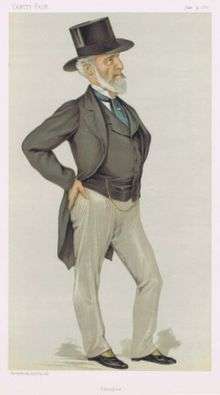Sir Charles Tennant, 1st Baronet
Sir Charles Clow Tennant, 1st Baronet (4 November 1823 – 4 June 1906) was a Scottish businessman, industrialist and Liberal politician.
Sir Charles Clow Tennant | |
|---|---|
 "Glasgow" Tennant as caricatured in Vanity Fair, June 1883 | |
| Born | 4 November 1823 |
| Died | 4 June 1906 (aged 82) |
| Occupation | Banker, industrialist |
| Spouse(s) | Emma Winsloe ( m. 1849–1895)Marguerite Miles ( m. 1895–1906) |
| Children | by Emma Winsloe (1821–1895): Pauline Emma (Posie) Tenant (1855–1888) by Marguerite Miles (1868–1943): |
| Parent(s) | John Tennant, Robina Arrol |

Biography
Tennant was the son of John Tennant (1796–1878) and Robina Arrol. His grandfather was the chemist and industrialist Charles Tennant, at whose article many other notable members of the family are listed. He was President of the United Alkali Company and Chairman of the Union Bank of Scotland. Tennant also sat as Member of Parliament (MP) for Glasgow from 1879 to 1880 and for Peebles and Selkirk from 1880 to 1886. He unsuccessfully contested Partick at a by-election in 1890. He was appointed Honorary Colonel of the 4th (Glasgow, 1st Northern) Lanarkshire Rifle Volunteer Corps (later 4th Volunteer Battalion, The Cameronians (Scottish Rifles)) in 1880.[2] He was also a Trustee of the National Gallery and was appointed a Member of the Tariff Commission in 1904. In 1885 he was created a Baronet.
In 1852, Tennant purchased The Glen, an estate in southern Scotland, and commissioned architect David Bryce to design a new house, which was completed in 1855.[3]
He was the driving force in establishing C. Tennant, Sons & Company as a merchant bank in the City of London.
Tennant was chairman of Nobel Explosives Company from 1900 to 1906. He died in June 1906 in Broadoaks, Byfleet, Surrey, aged 82, and was succeeded in the baronetcy by his son Edward, who was raised to the peerage as Baron Glenconner in 1911.
Family
Tennant's first marriage was to Emma Winsloe, daughter of Richard Winsloe, in 1849. After her death in 1895 he was remarried to Marguerite Agaranthe Miles, daughter of Charles William Miles and cousin of Sir Philip Miles in 1898. His second wife was a talented amateur musician and he bought the Lady Tennant Stradivarius for her as a gift.
His son from his first marriage, Harold Tennant, became a Liberal politician, while his daughter from his first marriage, Margot, was a socialite and author and the second wife of Prime Minister H. H. Asquith. His daughters by his second marriage included Katharine Tennant, Baroness Elliot of Harwood, Nancy, Lady Crathorne and Margaret, Lady Wakehurst. His granddaughter Kathleen became the Duchess of Rutland through her marriage to John Manners, 9th Duke of Rutland. His great-granddaughter Lady Ursula Manners served as a maid of honour to the queen at the Coronation of King George VI and Queen Elizabeth in 1937.
Notes
- Montague-Smith, P.W. (ed.), Debrett's Peerage, Baronetage, Knightage and Companionage, Kelly's Directories Ltd, Kingston-upon-Thames, 1968, p.488, Baron Glenconner
- Army List.
- Historic Environment Scotland. "The Glen, House and Service Wing (Category A) (LB19746)". Retrieved 28 March 2019.
References
- Millar, Alexander Hastie (1912). . Dictionary of National Biography (2nd supplement). London: Smith, Elder & Co.
- Davenport-Hines, Richard. "Tennant, Sir Charles, first baronet (1823–1906)". Oxford Dictionary of National Biography (online ed.). Oxford University Press. doi:10.1093/ref:odnb/36455. (Subscription or UK public library membership required.)
- Blow, Simon (1987). Broken Blood - The Rise and Fall of the Tennant family. London: Faber. ISBN 0-571-13374-6.
- Dugdale, Nancy (1973). Tennant's Stalk: the story of the Tennants of the Glen. London: Macmillan. ISBN 0-333-13820-1.
- Debrett, John; Kidd, Charles; Williamson, David (1990). Debrett's Peerage and Baronetage. New York: St Martin's Press. ISBN 0-312-04640-5.,
- Who Was Who
External links
- Hansard 1803–2005: contributions in Parliament by Sir Charles Tennant
| Parliament of the United Kingdom | ||
|---|---|---|
| Preceded by George Anderson Charles Cameron Alexander Whitelaw |
Member of Parliament for Glasgow 1879–1880 With: George Anderson 1879–1880 Charles Cameron 1879–1880 |
Succeeded by George Anderson Charles Cameron Robert Tweedie Middleton |
| Preceded by Sir Graham Graham-Montgomery |
Member of Parliament for Peebles and Selkirk 1880–1886 |
Succeeded by Sir Walter Thorburn |
| Baronetage of the United Kingdom | ||
| New title | Tennant Baronets 1885–1906 |
Succeeded by Edward Tennant |